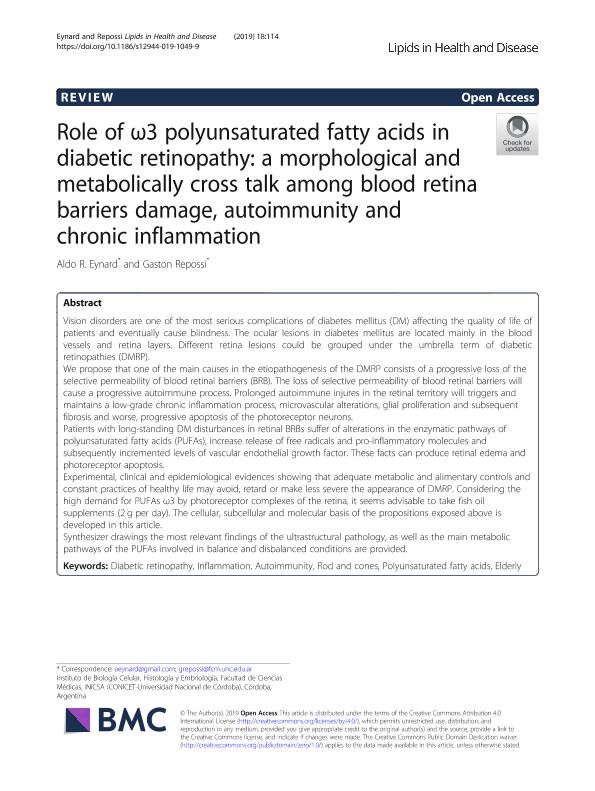Artículo
Role of ω3 polyunsaturated fatty acids in diabetic retinopathy: A morphological and metabolically cross talk among blood retina barriers damage, autoimmunity and chronic inflammation
Fecha de publicación:
15/05/2019
Editorial:
BioMed Central
Revista:
Lipids In Health And Disease
ISSN:
1476-511X
Idioma:
Inglés
Tipo de recurso:
Artículo publicado
Clasificación temática:
Resumen
Vision disorders are one of the most serious complications of diabetes mellitus (DM) affecting the quality of life of patients and eventually cause blindness. The ocular lesions in diabetes mellitus are located mainly in the blood vessels and retina layers. Different retina lesions could be grouped under the umbrella term of diabetic retinopathies (DMRP). We propose that one of the main causes in the etiopathogenesis of the DMRP consists of a progressive loss of the selective permeability of blood retinal barriers (BRB). The loss of selective permeability of blood retinal barriers will cause a progressive autoimmune process. Prolonged autoimmune injures in the retinal territory will triggers and maintains a low-grade chronic inflammation process, microvascular alterations, glial proliferation and subsequent fibrosis and worse, progressive apoptosis of the photoreceptor neurons. Patients with long-standing DM disturbances in retinal BRBs suffer of alterations in the enzymatic pathways of polyunsaturated fatty acids (PUFAs), increase release of free radicals and pro-inflammatory molecules and subsequently incremented levels of vascular endothelial growth factor. These facts can produce retinal edema and photoreceptor apoptosis. Experimental, clinical and epidemiological evidences showing that adequate metabolic and alimentary controls and constant practices of healthy life may avoid, retard or make less severe the appearance of DMRP. Considering the high demand for PUFAs ω3 by photoreceptor complexes of the retina, it seems advisable to take fish oil supplements (2 g per day). The cellular, subcellular and molecular basis of the propositions exposed above is developed in this article. Synthesizer drawings the most relevant findings of the ultrastructural pathology, as well as the main metabolic pathways of the PUFAs involved in balance and disbalanced conditions are provided.
Archivos asociados
Licencia
Identificadores
Colecciones
Articulos(INICSA)
Articulos de INSTITUTO DE INVESTIGACIONES EN CIENCIAS DE LA SALUD
Articulos de INSTITUTO DE INVESTIGACIONES EN CIENCIAS DE LA SALUD
Citación
Eynard, Aldo Renato; Repossi Marquez, Pablo Gaston; Role of ω3 polyunsaturated fatty acids in diabetic retinopathy: A morphological and metabolically cross talk among blood retina barriers damage, autoimmunity and chronic inflammation; BioMed Central; Lipids In Health And Disease; 18; 114; 15-5-2019; 1-15
Compartir
Altmétricas




